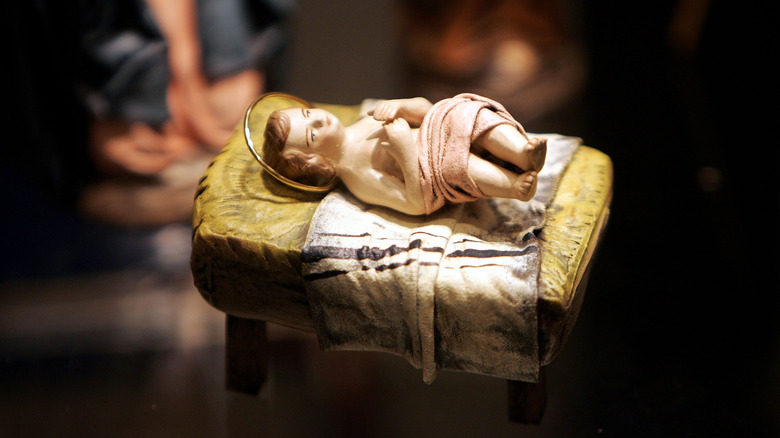Things People Get Wrong About Jesus
Even if you're not a Christian, chances are pretty good that you've heard of the religion's central figure: Jesus Christ. He's quite possibly one of the most pivotal figures in all of history, essentially kicking off what's still the world's largest religion, Christianity. It had an estimated 2.3 billion adherents in 2015, according to the Pew Research Center, accounting for over 30 percent of the share of world religions.
That's pretty darn good for a belief system that's about two millennia old and whose ostensible founder may or may not have believed that he was at the head of a sea change in religious thought. Regardless of whether or not he thought that he was the Messiah or Son of God, there's no denying the fact that Jesus was and still is a pretty big deal.
But even though billions of people profess faith in him and his teachings, there are quite a few misconceptions about Jesus Christ. From the basics of his appearance to accepted wisdom about his theology, there are a number of surprises in store. And, whether you turn to outside sources or solely devote yourself to studying the Bible, there are many gaps, contradictions, and open questions about the man himself. So, it may be time to adjust some of your basic assumptions about this pivotal and enigmatic figure, perhaps discarding a few of the more convenient and simplified stories along the way. These are the things people get wrong about Jesus.
Everyone assumes that they know what Jesus looked like
As much as a major world religion centers around him, there's surprisingly little direct evidence that clues us in to what Jesus really looked like. And, if you happen to have taken in some of the classic images of Jesus — that is, "classic" as defined by centuries of European-influenced art making — then chances are pretty good that your internal image of Jesus is all wrong.
According to History, the Biblical evidence about Jesus' appearance is practically nonexistent. We know that he would have been about 30 years old when he started making waves as a religious leader. It's also pretty reasonable to conclude that he was a normal-looking guy for the time, so standard issue that Judas Iscariot had to point him out when it came time for Jesus' arrest by Roman authorities. And that's pretty much it, unless you really want to grasp at straws with a couple of other verses. It doesn't help that Western art has changed its depiction of Jesus many times over the years, often depending more on cultural trends and personal preferences of the artist than documented fact.
That said, we can make some reasonable conclusions about his appearance, extrapolating from common traits seen around the region at that time. In "What Did Jesus Look Like?," academic Joan E. Taylor puts forward an educated guess that Jesus likely had curly hair, dark eyes, and brown skin, much like other people of his community.
People think Jesus was a carpenter
It's often plainly stated, as if it were a simple fact, that Jesus began his life as a humble carpenter, working with his hands and in obscurity before he became a major religious figure. However, the use of the word "carpenter" isn't quite right here.
In reality, the original Greek text of the Gospels refers to Jesus and his earthly father, Joseph, as tektōn, according to the Journal of the Evangelical Theological Society. And also, for what it's worth, there are only two verses (Mark 6:3 and Matthew 13:55) that even bother to reference Jesus' occupation or that of Joseph. It seemingly wasn't all that important, or not to the writers of the Gospels.
According to Architectural Histories, the job description of a tektōn can include plenty of woodworking, especially given that wood was a pretty common building material for the time and place that Jesus would have been working in. So, doesn't that mean he was a carpenter? No, not really. Rather, a tektōn has been defined in any number of ways, with jobs that can encompass carpentry work, but is more often generally defined as "builder." It may be more accurate to think of Jesus and Joseph as general contractors of Nazareth. It appears that we got to "carpenter" because, when English translations of the Bible started to debut, there was already an established tradition of referring to Jesus as a carpenter, despite the lack of clear Biblical evidence.
Jesus was born on December 25th
Now, this one may seem painfully obvious. Why else would so many Christians celebrate the birth of Christ every year on December 25 if he wasn't born on that date, more or less? Only, if you managed to travel back in time to the first few centuries after Jesus' death, you'd be hard-pressed to find any celebration of his birth, much less one taking place around that time of year.
According to History, the oldest known record of a Christmas-like celebration is an observation of the Nativity that took place in Rome in 336 C.E. Before that, no one claimed to know at what time of year Jesus would have been born, nor did they seem very concerned about it. Easter, which commemorates Jesus' crucifixion and resurrection, was considered far, far more central to the Christian celebratory calendar. Later, theologians would contend that God had created the world on the spring equinox, meaning that Jesus was probably conceived around that same time of year (the lack of Biblical support notwithstanding).
There's no directly stated reason why early church leaders picked December 25 as the holiday. As Britannica notes, a Roman historian recorded Jesus' conception as March 25, so adding nine months to that would be December 25. Another commonly believed but not proven connection is with the Roman festivals honoring Saturn and Mithra, which occurred around the end of December. It could be that, as Christianity began to make inroads across the globe, it was relatively easy for proselytizing monks and other missionaries to incorporate their Christian observances into Roman's pagan celebrations in order for them to better accept Christianity.
People believe that there is very clear evidence for Jesus outside of the Bible
History reports that scholars commonly accept there was a real, historical Jesus. However, the more complicated truth is that direct evidence for his existence is frustratingly hard to come across. So, while we can be reasonably certain that there was once a religious leader named Jesus who lived in what's now Israel around the 1st century, things after that point get murky pretty quickly.
First, there is no documented archaeological evidence for Jesus, meaning that no one has yet found any tangible things that are for sure connected to the man. Yes, this means that even long-venerated religious relics, like the supposed crown of thorns traditionally housed in Notre Dame Cathedral or bits of the "true cross" displayed elsewhere are unconfirmed.
So, if that particular set of proof is lacking, what about documentary evidence? That avenue has proven more useful, though not exactly fruitful. Some non-Biblical writers did confirm a few spare details of Jesus' life. Flavius Josephus, a Jewish historian living in the first century, offers up one of the earliest such accounts. In his "Jewish Antiquities," Josephus writes that of a man named James who was unfairly executed, mentioning that the victim is the brother of "Jesus-who-is-called-Messiah." Yet, a longer account may have been doctored by later Christian editors. Another brief mention comes in the "Annals of Imperial Rome," where historian Tacitus refers to a man who, by the second century, was called "Christus."
Jesus had long hair
Quite a few depictions of Jesus over the centuries have shown him with long, rather gorgeous hair. The savior should, after all, have nice, flowing locks, you can imagine many artists thinking to themselves. It certainly wouldn't do if he had a boring short cut like so many other people throughout history, anyway.
But it could well be that Jesus didn't have the long, flowing tresses that you see in innumerable paintings, movies, and TV shows. It's a good look but, as it turns out, not strictly a historically accurate one. According to the BBC, having a big old beard and long hair was typically the mark of a Greek or Roman god, such as Zeus. Everyday people would have been far more likely to be clean shaven and short-haired. In fact, the earliest known images of Jesus from the 3rd century show him in just such a manner.
There is a bit of an out here, though. If Jesus were traveling about preaching, he may not have had time to visit a barber and could have developed something of a beard. But the long hair would have surely marked him out as a member of a group known as the Nazirites. Yet, because no one ever claimed Jesus was a Nazirite and because he drank wine (another no-no for the Nazirites), we can make a reasonable conclusion that he had short hair and, at most, a short beard like everyone else.
Everyone's certain Jesus was chill
Jesus was, by many modern accounts and retellings of his story, a generally loving guy who preached peace and togetherness during his time on Earth. You certainly can't deny this, as there are plenty of Bible verses where Jesus tells people to love one another and he is commonly known in Christian circles as the "Prince of Peace" (via Christianity.com).
But it would be a mistake to assume that Jesus was a constantly smiling, chill sort of person who gave out free hugs all the time. In fact, there are plenty of Biblical verses that underlie his very human nature of getting angry on occasions, according to Got Questions. There's the incident where he overturned some tables and upset moneylenders working in Jerusalem's temple, a story so striking that it's mentioned in three Gospels (Matthew, Mark, and John). He was also known to get clearly frustrated at people who weren't cottoning to his teachings, as when the Pharisee fundamentalists wouldn't answer his questions, in Mark 3:1-5.
According to Got Questions, it's not that Jesus' anger was a bad thing, especially considering that no Bible verses really indicate that his emotions tipped over into uncontrolled rage (though the moneylenders may have argued otherwise at the time). Neither is there any textual evidence that Jesus stewed over his anger and allowed it to become a grudge. For many believing Christians, while this may be a surprising point of Jesus' actions and personality, his anger appears righteous.
People are sure his name was Jesus
Though it's the name many of us know him by today, the first century Jewish religious leader and prophet who is now called "Jesus" would have never heard that name applied to him during his lifetime. According to PBS' Origin of Everything, his original Hebrew name was actually "Yeshua." If we were to literally translate that to a more modern form, the originator of Christianity would more accurately have gone by "Joshua."
So, how did we get to Jesus? It's all due to the Greek language employed in the New Testament. His name went from "Yeshua" to "Iesus," namely because Greek just didn't have the same characters to handle the sound of the original Hebrew. "Iesus," which rather easily became "Jesus" down the line, was their best approximation.
What's more, Jesus wouldn't have been alone in the name game. As Slate reports, Yeshua would have faced the same problem borne by modern kids with popular names: everybody in the region, it seems, was named "Yeshua." It certainly pops up often in the Hebrew Bible, though those individuals often became "Joshua" in later translations. Furthermore, just from the time of Jesus' crucifixion, excavators have uncovered over 70 tombs bearing the name. Not only does that make it incredibly hard to find archaeological evidence of Jesus' tomb — which would be an absolutely groundbreaking discovery for Biblical archaeology — but it underlies just how initially common and unremarkable Jesus may have seemed upon first glance.
People think there are eyewitness accounts of Jesus
Given how many stories there are of Jesus' life, like the Gospels of Matthew, Mark, Luke, and John, surely this means also that there are some pretty good on-the-ground reports of his activities. Only, there really aren't. There are accounts that get decently close within a generation or so, like historian Flavius Josephus' first-century record that references Jesus (via History).
But, when it comes to eyewitness accounts from people who actually met the man, things get pretty shaky. Speaking to NPR, religion professor Bart D. Ehrman notes that we can't be so sure that the Gospels were actually written by Matthew, Mark, Luke, or John. Instead, it's quite possible that later writers simply attached the names of the apostles to their work. If they were actually written by the people in question, then why are there so many significant differences between the details of the Gospels, like whether or not Jesus was divine?
Perhaps most significantly, there's no language in any of the Gospels that clearly indicates the writer was there. And wouldn't it have bolstered the account to say it was an eyewitness story, especially in the early years of Christianity when the religious movement was just getting started? The faithful may argue against this idea but, looking at things strictly from the perspective of the text, there's no confirmed proof that the apostles or anyone else who was part of Jesus' circle ever wrote down their own accounts.
Jesus was a Christian
Contrary to some modern folks' expectations, there's practically no way that Jesus would have thought of himself as a Christian. First of all, as the BBC reports, the "Christ" part of Jesus Christ was not a feature of his actual name. It's actually a Greek word related to a Hebrew term for "messiah" and is effectively translated as "anointed one." It's a title more than anything else, and one that seems to have only really caught on after Jesus' death, per Britannica. So, on at least one level, he simply couldn't have thought of himself as "Christian."
Moreover, PBS's Frontline contends that Jesus would have very likely seen himself as a Jewish person. He was born in a Jewish community, to a Jewish family, and would have been intimately familiar with the various laws and practices of Judaism in the first century. As professor Shaye J.D. Cohen argues, even the Gospels tacitly assume that Jesus was Jewish, with nary a mention of him starting a new religious movement, much less one that would be called "Christianity."
For Jesus and everyone around him, it's far more certain that he was seen as someone with a unique connection to God, but not an individual in the process of breaking away from established Jewish tradition (at least no more than other existing sects within Judaism). It's only after that religious movement grew into independent Christianity over the following centuries that anyone would consider otherwise.
Everyone thinks the divinity of Jesus is crystal clear
One of the greatest debates in the realm of religious studies and Christian theology seems to be the matter of whether or not Jesus believed that he was actually divine. Not divinely inspired, not metaphorically the "Son of God," but genuinely imbued with a spark of something beyond humanity. What's the right interpretation?
Turning to the Bible may give you more conflicting answers, according to the BBC. The Gospel of Mark at first seems to accept the idea of a divine Jesus, but then includes a couple of verses in Mark 10:17-18 where Jesus himself seems to deny being directly related to God. But Matthew 1:22-23 seems to make a more obvious connection between man and deity, noting that another name for Jesus, Immanuel, means "God is with us."
Fine, the New Testament is a bit scattershot on the subject, but did Jesus himself ever confirm the situation one way or another? Religion professor Bart D. Ehrman, talking to NPR, says that the Gospel of John is the most direct in that respect, with claims that Jesus essentially said that he and God were the same. Only, Ehrman claims that he and other scholars are a little suspicious of the Gospel of John's accuracy. The Gospel's author may have been more invested in making a theological point than transcribing actual history or documented words of Jesus. It is clear, however, that later scholars and leaders wanted to imbue Jesus with divinity.
People are sure he was crucified on a cross
The story of Jesus' crucifixion is so central to Christian belief that the structure on which he met his mortal end is now one of the most commonly seen religious symbols across the world. For many of the faithful, it would be supremely odd to worship without a cross somewhere in sight or even on their person. But is the Christian cross that adorns so many churches, rosaries, necklaces, charity logos, and more accurate? Maybe — or maybe not, depending on who you ask. For instance, Jehovah's Witnesses maintain that not only did Jesus die on a plain upright stake, but that the t-shaped cross seen in other churches is actually a blasphemous pagan survival.
Other Christians have their doubts, too. In 2010, theologian Gunnar Samuelsson told ABC News that his own in-depth research revealed little evidence to support the t-shaped cross image, even when he went to the Bible for evidence. He points to confusion over the Greek term "stauros," which could generally refer to a suspension structure used to kill or punish criminals in the Roman Empire. This potentially means that what we now call a crucifixion could have indeed taken place on a simpler arrangement like a big pole. Still, even if we haven't got the shape of the cross quite right, death in this manner would have nevertheless been brutal, with suffocation and exposure likely dealing the final blows after a long and tortuous period of suffering.
He was nailed to the cross
Most Christian traditions hold that Jesus was viciously nailed to cross, a step that was undoubtedly painful and meant to increase his suffering. Yet, the historical evidence surrounding crucifixion is less than clear about this particular detail.
There is striking evidence that at least one person was nailed to a cross. In 1968, excavators found the remains of a first-century Jewish man who had been laid to rest in Jerusalem. Amongst those skeletal remains was an iron nail still embedded in his heel bone. The initial analysis made big conclusions that the man was crucified with his arms outstretched and a single nail through his feet. However, a 1985 analysis by Joseph Zias and Eliezer Sekeles published in Israel Exploration Journal found that these claims were stretching the evidence too far. Yet, both agreed that the man was almost certainly crucified, including the gruesome step of being nailed to an upright beam.
But did Jesus get the same treatment? That's less certain, in large part because there's no physical evidence for it. The Gospels are inconsistent here, as well, with the Gospel of John noting the hand wounds of a resurrected Jesus. However, others only vaguely refer to a cross and don't explain exactly how Jesus was affixed to it. Moreover, early art appears to show Jesus tied to a cross, which reflects Roman practice.
Many assume Jesus was single
One of the most controversial facets of the Jesus story centers, as with so much gossip both ancient and modern, on the man's personal life. As many faithful Christians will be sure to tell you, Jesus was very definitely single. But, while your local priest and religious grandma may both balk at the idea of Jesus being anything other than totally celibate, the more difficult truth is that the Bible is quiet on the issue.
It's true that none of the currently canonical books of the Bible say anything about Jesus being married or even looking at someone in a romantic sort of way. But there is a tantalizing bit of fourth-century papyrus on which a fragment of Coptic text has Jesus referring to his wife. Soon after it came to light in 2012, scholars rushed to debate the line, which had some arguing that Jesus really was married ... or at least early Christians believed he was. Only, as The Atlantic reporter Ariel Sabar found, there are serious issues with the document's authenticity, not least because it's linked to a possible German forger with profit and notoriety on his mind.
Despite the papyrus controversy, it's worth noting that the Bible never definitively says whether Jesus was celibate or single. What's more, it may have been considered strange if Jesus wasn't married, as that would have been supremely unusual for a Jewish rabbi at the time.
Jesus was the only roving preacher at this time
Surely, Jesus was one of a kind. However, it's not fair to assume that Jesus was the only holy man in first-century Galilee. Widespread political and religious upheaval in this outpost of the Roman Empire set the stage for a variety of upstart preachers and different religious movements within Judaism. These included the relatively intense Essenes, who lived in communities that adhered to strict rules and who set themselves apart from everyday life. Two other major groups, the Pharisees and Sadducees, were more enmeshed in daily society, though both had unique interpretations of religious laws. Most Jewish people didn't belong to any of these, though high-ranking priests and other powerful figures were more likely to be Pharisees or Sadducees.
Then, there were the individuals who drew interest for their religious teachings and reported miracles, from the hermit Bannus, who was an adherent of one of the strict Jewish sects of the time, to Honi HaMe'aggel (or Honi the Circle-Maker), who reportedly called down much-needed precipitation after drawing a circle in the ground and informing God that he would stay there until it rained. When the rain didn't meet his standard, he told God to change it up. It reportedly did, though this drew the ire of people who said he was disrespecting the Almighty.
Even Jesus was tended to by another religious firebrand — John the Baptist. Now regarded as a sort of herald for Jesus, John was already gaining recognition for his preaching and rite of baptism in the Jordan River, where he baptized Jesus.
Everyone says he was born in a stable
Around the winter holidays, you may see Nativity scenes pop up that depict Mary, Joseph, and the newborn Jesus cuddled up in a stable. Animals and shepherds often join the adoration party, while the baby is placed in a feed trough commonly known as a manger. For many, this has become an iconic image of Christmas, but it may not be wholly accurate.
Once again, the confusion comes down to issues with translation. As some theologians like the Reverend Ian Paul have pointed out, the original Greek of the New Testament uses the word kataluma. Modern translators have interpreted this to mean inn, but it may be more accurate to think of the kataluma as a guest room in a home. Given the importance of familial ties in Jewish society, not to mention the fact that Joseph and Mary were traveling to Bethlehem for a census count with their larger family, it would be odd for them to stay in a proper inn (usually referred to as a pandocheion).
They were likely staying with family but, given the influx of people for the census, had to sleep in a lower level of the house. This was also likely the place where animals were brought in at night. This take on the Nativity has been causing upset since at least 1584, when Spanish theologian Francisco Sánchez de las Brozas proposed the idea and was reported to the Inquisition for his troubles.
People assume he was born in Bethlehem
Even if you only half-listen to the Christmas story, you've probably heard that Jesus was born in Bethlehem. Mary and Joseph were obliged to travel there for a census count, though Mary was on the verge of giving birth. Only, if you take a closer look at the Gospels, basic details like the birthplace of Jesus are more up for debate than you might expect.
The Gospels of Matthew and Luke do claim that Jesus was born in Bethlehem, though they differ on certain key details. For instance, Matthew throws in the narrative thread about a star guiding wise men to Bethlehem, while Luke mentions no such thing but does claim that angels directed shepherds to worship baby Jesus. Meanwhile, the Gospel of Mark (the earliest written account, from about A.D. 60) doesn't mention Bethlehem at all. The Gospel of John likewise fails to link Jesus and Bethlehem. Other texts of the New Testament, like the Book of Revelation or just about anything written by the apostle Paul, don't make the connection, either. Then again, Paul may have had an ulterior motive, wanting to cut the link between new Christianity and the older Jewish traditions linked to Bethlehem and Jesus' big-name ancestor, King David.
So, if not Bethlehem, then where? It could simply be Jesus' hometown, Nazareth. Heck, given the inconsistencies of the Bible and other early Christian writers, it could be anywhere else. This question may very well stay unanswered.
Some believe he was tall
Starting in the 19th century, some thinkers began to put forth an idea known as the Great Man theory, which essentially maintains that some people are born leaders. Thomas Carlyle, an early proponent of the notion, put a distinctly religious spin on it, telling all of us normies that it was our job to lift up the far-seeing, moral, and masculine Great Man. Some have since modified this idea to include a number of physical characteristics that, rightfully or not, have been linked to leadership, like greater than average height.
So, if Jesus is widely considered to be the greatest of Great Men, then surely he was tall. At any rate, artworks often depict him as taller or at least more prominent than other figures. Take the Shroud of Turin, which was once believed to be Jesus' burial cloth and was said to have been mystically imprinted with his image. The shroud has since been definitively identified as a medieval European creation, which is perhaps not all that surprising when you consider it shows a man who would have been about six feet tall.
Yet, there's no Biblical or historical evidence that indicates Jesus was towering above everyone else. In the absence of anything to the contrary, it's more reasonable to conclude Jesus looked a lot like other people of his time and place. Since the average height for a first-century Jewish man was 5 feet, 5 inches, it's more likely Jesus was average height, too.
Jesus was all serious, all the time
A close look at Jesus' words and actions in the Bible indicates that he may have been not just charismatic but funny. There's the basic argument that, at least according to many Christians, Jesus was human. Even the most serious humans in your life are likely known to have cracked a smile or two, so it stands that Jesus enjoyed a good joke. There are also Jesus' parables, like his statement in Luke 18:25 that "it is easier for a camel to go through a needle's eye, than for a rich man to enter into the kingdom of God." Seen in a certain light, this could be an absurdist joke — go on, try to imagine a camel jamming itself through a needle's eye — rather than a fully serious proclamation.
If you need a more obvious example, know that Jesus wasn't above making a saucy joke, too. In Luke 14:15-24, Jesus tells a story of a man planning a banquet. Yet his potential guests keep making excuses, with one saying he needs to examine his newly purchased field. Another claims that he has to test out a new team of oxen, and finally a third says that he's just married, implying he's got something else to keep him busy. Other parables could easily have been Jesus satirically taking the air out of self-important figures, like the colonizing Romans and the know-it-all Sadducees and Pharisees. Well, maybe you just needed to be there.
Many believe he confirmed Heaven and Hell's existence
Surely Jesus, as one of the biggest names in religion, had a lot to say about Heaven and Hell. Not exactly. Ancient Jewish teaching held that the dead were just, well, dead and went to a place called Sheol — originally, a term for the grave. By the time of Jesus, many had come to believe in some sort of afterlife, as well as the idea that God would eventually judge everyone. The good would be rewarded, while the less-so would be erased but not made to eternally suffer for their wrongdoings. Jesus' innovation was to tell everyone that gaining access to a good afterlife hinged on loving God and treating others well, rather than following strict religious laws.
But, where Jesus speaks of Hell in English translations of the Bible, the original complicates things. In Matthew 5:22 and 5:29-30, what's translated as "Hell" in many versions was originally geennan, a Greek transliteration of Gehenna.
Gehenna was a valley outside of Jerusalem where children were reportedly once sacrificed to pagan gods, and which some non-ancient sources say became a smoldering garbage dump. Other Jesus quotes seem to reference this concept, which seems to imply that remains of evildoers would be metaphorically cast into fire while also implying that sinful souls would eventually wink out of existence. An afterlife of eternal torture is never clearly referenced by Jesus, who focused more clearly on eternal reward without explicitly describing Heaven or Hell.
Jesus didn't exist at all
Presented with all of the misconceptions and shaky evidence surrounding the figure of Jesus, it may be tempting to throw up your hands and conclude that the man never existed in the first place. Yet, the evidence, patchy and circumstantial as it may be, is still strong enough to show that Jesus was a very real person.
Religion scholar and professor Bart Ehrman told NPR that the early Christian apostle, Paul, claims to have met not just the apostle Peter, but Jesus' brother, James. It's not a first-person account of Jesus, but it is pretty darn close. Ehrman also argues that the earthly downfall of Jesus is a key piece of evidence. If someone had made up a mythical son of God who had come to redeem all of humanity, why would they also have him taken down so easily and in such humiliating fashion? Other accounts that place Jesus in a less-than-heroic light indicate that he was real, such as when he was baptized by the supposedly lower-status John the Baptist.
Moreover, we shouldn't discount the records of Jewish and Roman writers who reference Jesus, even if they were a generation or two removed. Take Pliny the Younger's account of Christian worship. His observations that early Christians "sing responsively a hymn to Christ as to a god" hints that the second-century Pliny was aware of Jesus as a historic figure and that this worship of a man struck him as odd.




















